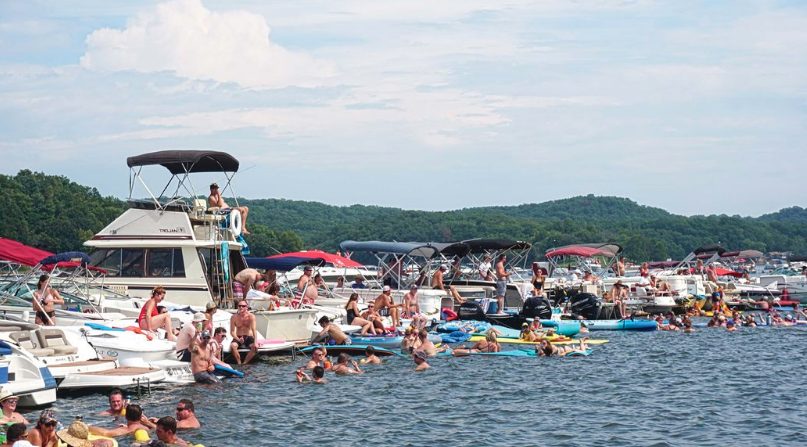A Guinness World Record was set on August 14, 2010 at Kentucky’s Lake Cumberland when 1,651 boats were strung together making it the largest boat tie-up in history. While your own raft-up might pale in comparison to the magnitude of that tie-up there are still some important techniques and rules you should follow. Find this list below and learn the proper raft-up etiquette for your next outing.

Ask First
If you see a raft-up of a couple of boats in your local cove, don’t just assume there’s an open invitation to join the party. Sometimes a small group of friends or family members is looking to spend time with each other on the water and not necessarily wishing to join in a giant party. If that’s the case, move to a different spot in the cove, leaving enough distance between you and them to enjoy the water around their raft-up, and also to account for any tide, current swing or change in wind direction.
The Biggest Job
If you’ve planned ahead with a group of boaters to form a raft-up, make sure the heaviest boat in the fleet is the one to drop anchor. Hopefully that boater has equipped his ground tackle with an anchor appropriate to his boat size, with a sufficient length of chain to keep the anchor set on the bottom and prevent dragging. The lead boat should set the anchor line to at least a 7-to-1 scope, meaning he should let out 70 feet of anchor line for every 10 feet of depth.
Once the lead boat is set, hang appropriately sized fenders off each side and allow other boats rafting up to join on alternate sides to keep the lead boat in the middle. (Better hope the anchored boat doesn’t have to leave early.)
Slow Like a Pro
Never approach a raft-up at anything other than idle speed, to minimize your wake, prevent crashing into other boats, and avoid swimmers or people hanging on rafts or tubes in the water. Just like when you approach a dock, keep your hands and feet inside the boat at all times and never use your extremities as human fenders. Bone breaks before fiberglass. A boat hook is a handy tool in a raft-up because it allows the crew on one boat to reach for the other and, once the boat is secured, allows the captain to kill the engines so the crew can throw dock lines and bring the boats together by hand rather than horsepower.
Cleat to Cleat
Even though boats joining a raft-up will be of varying lengths overall, make every effort to tie at least two dock lines—one at the bow or midship and one at the stern—to each boat’s cleats.
Don’t Take the Beach
If there is a raft-up in place along a beach, cove or sandbar, don’t circle around it on the inside. Oftentimes, raft-up revelers are jumping off their boats and swimming to shore to explore. Keep your motorized activity on the offshore side of the raft-up to avoid people in the water. And while many love to beach their boats sometimes, don’t tuck into the sand right in front of a raft-up. Besides being bad form, it’s dangerous.
Stay Sober
As tempting as it might be for the captain to partake in the partying, if you’re going to be operating the boat at any point in the day, don’t drink.
Source: Boating





